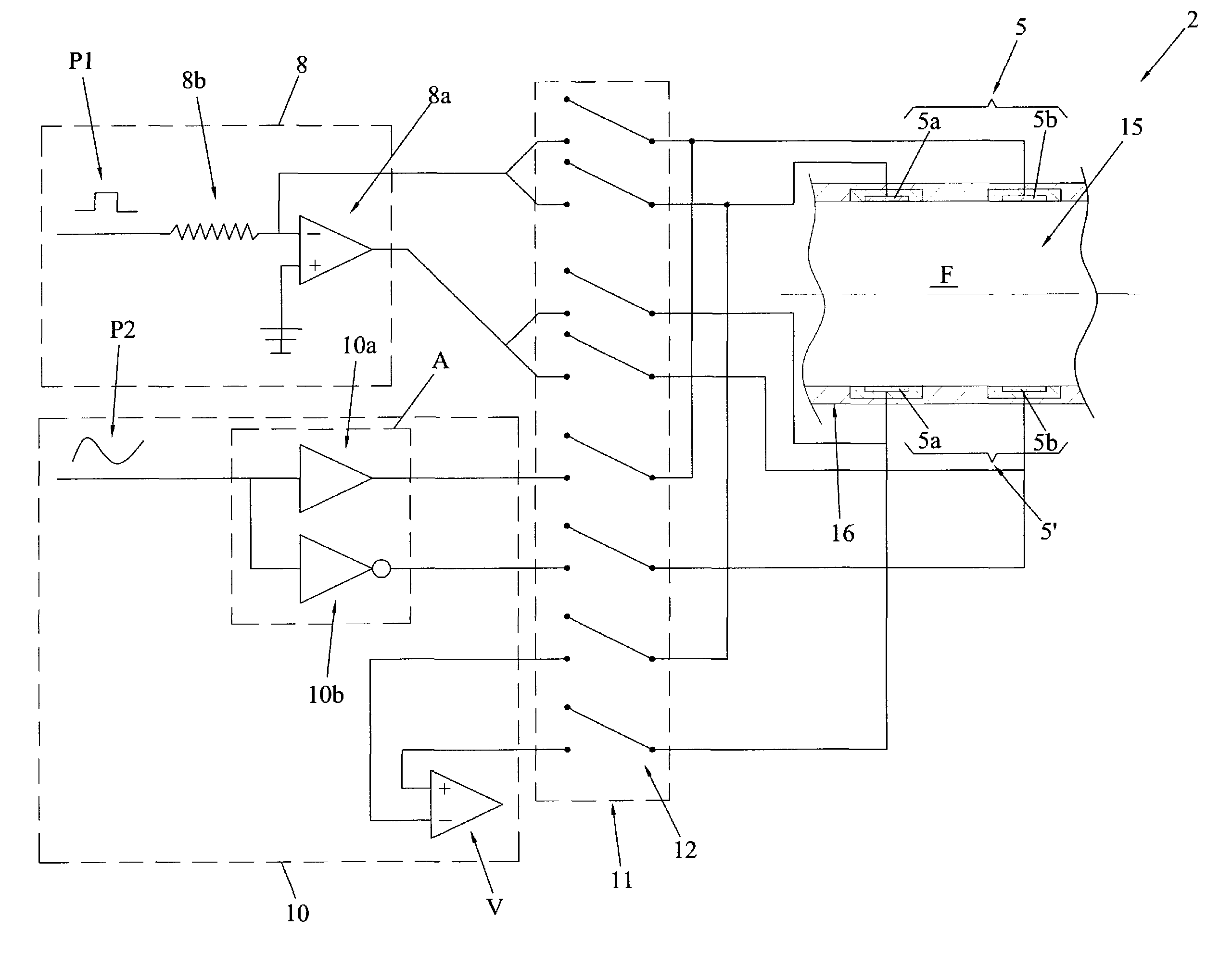Device for the measurement of electrical properties of fluids and method for measuring said electrical properties
- Summary
- Abstract
- Description
- Claims
- Application Information
AI Technical Summary
Benefits of technology
Problems solved by technology
Method used
Image
Examples
embodiment 7
[0143]Therefore, advantageously and as previously pointed out, the embodiment 7 allows the speed, the dielectric permittivity and the electrical conductivity of the fluid F to be measured using a single device 3.
[0144]Consequently and advantageously, the device 3 is more compact and constructively simpler than the known devices that perform the same functions, both from the mechanical and electronic point of view.
[0145]It is clear that the three zones 7a, 7b and 7c comprising each electrode 7 can be constructed with any shape, even different from that represented in the figures, maintaining in any case the functions described above.
[0146]Whatever the shape of the electrodes, they are associated with a support structure which, preferably but not necessarily, is the pipe 16 transporting the fluid F.
[0147]The aforesaid support structure 16 is the electric earthing of the system and defines its reference voltage.
[0148]Preferably, as can be seen in FIG. 1a, the electrodes 4, 4′ are assoc...
embodiment 6
[0193]Clearly, instead of the electrode 5 of FIG. 2, the aforesaid method could be equally applied to a device including the embodiment 6 of FIG. 3, or any other embodiment having two separate sectors.
[0194]A further embodiment of the method of the invention uses the device 3 illustrated in FIG. 6a, in which a sector of each electrode 7, 7′ includes at least two separate zones 7b and 7c of electrical contact with the fluid F.
[0195]Preferably, in this case, the method includes a third phase consisting of a sequence of measurements of only one electric quantity, dielectric permittivity or electrical conductivity, performed in sequence between each of the two corresponding pairs of zones 7b-7b and 7c-7c on the two electrodes 7, 7′, as shown in FIG. 6c.
[0196]Advantageously, the aforesaid measurements can be processed by means of a cross-correlation algorithm known per se, in order to determine the speed of the fluid using a single measuring device 3.
[0197]In addition to the measurement...
third embodiment
[0199]In particular, the device of the invention is more compact than the known devices with equivalent functionality, as it uses a single pair of electrodes to measure the dielectric permittivity of the fluid, its electrical conductivity and, in the case of the third embodiment described, also its speed.
[0200]In addition, the measurement of the conductivity and the permittivity is done by using a single pair of electrodes, so as to allow the execution of both measurements for the same zone of the fluid, with the advantage of ensuring a higher degree of precision compared to the known electrodes.
[0201]Similarly, the separation of each electrode in two sectors allows the attainment of greater measurement precision compared to the known devices, inasmuch as it enables the execution of the “four-wire method” measurement.
[0202]Upon implementation, the device and method of the invention can be subjected to further improvements or changes that, although not described herein and not repres...
PUM
 Login to View More
Login to View More Abstract
Description
Claims
Application Information
 Login to View More
Login to View More - R&D
- Intellectual Property
- Life Sciences
- Materials
- Tech Scout
- Unparalleled Data Quality
- Higher Quality Content
- 60% Fewer Hallucinations
Browse by: Latest US Patents, China's latest patents, Technical Efficacy Thesaurus, Application Domain, Technology Topic, Popular Technical Reports.
© 2025 PatSnap. All rights reserved.Legal|Privacy policy|Modern Slavery Act Transparency Statement|Sitemap|About US| Contact US: help@patsnap.com



